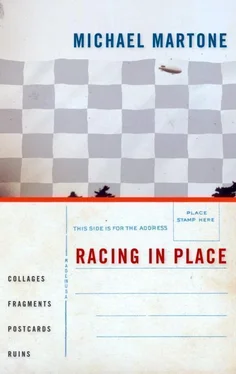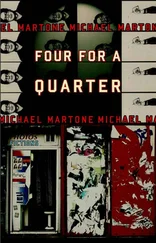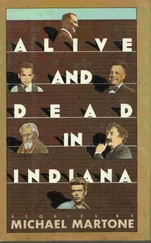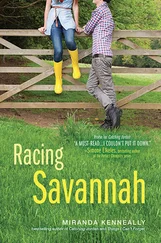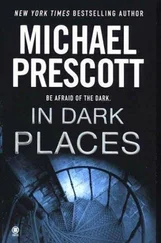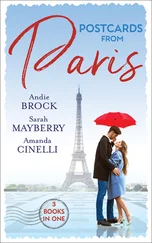We always got there early. Sometimes we stayed by the car and tailgated in the parking lot, eating our lunch from a cooler in the trunk. But more often, especially when we were with some of my father's old high-school teammates, we would all drift over to the field house to look at the names of the lettermen on sacred plaques, admire the immaculate cases of memorabilia, trophies, and photographs of the old great and holy teams. My father had gone to Central Catholic in Fort Wayne. They had been the Fighting Irish too, and in his senior year, his team had won the mythical state football championship. My father, who had been quarterback, and his old backfield would recite the names on the plaques, remind each other of games they'd played in or seen.
Most of all I liked it when we went to the far end of the stadium before the game, to the locker room door. A crowd had always gathered to wait and watch for the Notre Dame players to emerge alone or in small groups, threes or fours, from their campus dorms and drift toward the stadium, wading through the crowd into the locker room. The players were huge. None of them had necks. They were stuffed into the insignia-dripping letter jackets of dark blue wool with glossy blue-black leather sleeves.
Touchdown Jesus looked down on us all gathered in the plaza before the locker room door. Look, there were some more coming our way! Often, just by the door, there was a boy-it was never the same boy-about my age, waiting in his wheelchair or leaning on his crutches, his body mangled into a cast or contorted or quaking with palsy. The players had been tipped to his presence. The crowd parted as they approached. The players tolerated the back-pats and the praise as we moved to make room. We just wanted to touch them, to get a word in. They said "excuse me" politely, didn't stop for us as they made their irresistible journey toward the door. But when they spotted the kid by the door they were drawn to him and to the football that miraculously appeared in the folds of his hospital blankets, in the crook of his traction-set arm. We all watched as each player took the ball to sign it, signed it, and handed it back to the bandaged kid, saying a few inaudible-to us-words and then tousling his hair with their beefy hands before disappearing into the changing rooms to be transformed for the game.
My Mother Invents a Tradition
At our dining room table in the house on Clover Lane in Fort Wayne, my mother made it all up. She was the dean of girls at Central High School. The city school system had announced Central's closing and the busing of its students to the six other high schools in the system, two of them, Northrup and Wayne, just being built. Mom would be going to Northrup, and her job now was to manufacture the particulars of the new school's identity. There was a committee, a group of students and teachers drawn from the constituencies of Central and the two northside schools siphoned off by the expansion.
I remember the group listening to records of marching bands playing fight songs and alma maters, the words absent, in our living room. They rated the melodies on graph paper with scales from 1 to 10. "This is `On Wisconsin!"' my mother would say. And one evening the band uniforms and cheerleading costumes were modeled and judged there too, but that was much later. My mother had to do the heavy lifting of the task force, actually writing the words to the songs the band members would play in the future. She would also narrow down all the choices of styles and colors in the catalogues she gathered from the wholesalers of academic garb, the purveyors of embroidery and emblems, the flag-makers, the jewelers, trophy stores, yearbook printers, decal suppliers, and fund-raising companies. Then she would guide the committee to her favorites.
At the dining room table she had to get herself in the mood for her creations. For this new school she was constructing a nostalgic past out of nothing. It was named for a former superintendent, no help there. So she relied on the stored memories of her own high school, the images of high school created in movies she saw while she was in high school. There had been ivy on the red brick walls and a senior door only seniors could walk through. Every year the graduating class planted a climbing rose bush along the fences of the stadium, and the trowel used for the job was handed down to the next class at a ceremony in the spring as the roses budded and began to bloom. Northrup had none of these rituals as of yet, it was being built in a scrapedflat cornfield on the northern edge of town. The excavation left a few trees from a woodlot nearby, and mother mused to me that perhaps that could become a lover's lane. She imagined the moon over the copse of trees. "The students," she wrote for the students in the new handbook, "call this spot Lover's Lane."
I was in high school then, at North Side, my mother's high school, the one she waxed with nostalgia as she worked at the dining room table. At North Side now no one remembered why the seniors gave a garden trowel to the junior class. The rose bushes had been torn out during a renovation before I started there.
She went with orange and brown for Northrup's colors, presented them to the committee as a fait accompli. It was the early '70s, and those colors were hot. Our sofa was orange and brown striped. The other new high school, Fort Wayne Wayne-I know, it is very funny name-was forced into red, white, and blue since its mascot, the General, followed from the name. Mom had more leeway and went with the palette of the moment. She trusted that her words for the school songs, the cheers, the student codes, and the orientation materials would give the colors a patina, age them in a tea of her own emotional past.
The mascot would be a Bruin. This seemed more sophisticated than the simple Bear, and perhaps it fit the same logic of euphemism left over from Central, the school that was closing, where the team mascot, Tiger, had also been known as the Bengals in the sports pages. Bruin went nicely with the earthy tonic expressed in the newly selected colors, rhymed with ruin, and suggested the whole conceit for student publications. The newspaper, she decided, would be called What's Bruin and the yearbook known for years to come as Bear Tracks.
At the dining room table she wrote the poems that became the fight song and the alma mater. I have no notion of the words themselves. They survive to this day, sung at assemblies and home games. I went to a different school and never had to learn them. I can remember her singing, though, trying to fit her words into the scansion of the appropriated songs. As I watched her sing a few bars then stop and erase then sing a few notes more, I was making this memory of my mother creating memories and the myths of memory. A few scraps of cloth. A totem or two. Some new arrangement of the same old words hooked to a persistent jingle.
A Cyclone of Cardinals
Midwesterners like to think a tornado is the region's official natural phenomenon. It's their pet weather, their special storm. The twister in the black and white Kansas of the movie is more powerful and magical than anything in glitzy Oz. The citizens of Xenia, Ohio, where all the tornado alleys empty, speak nervously but with a kind of pride about their repeated visits of destructions. With its precision and its paradoxes, a tornado fits organically into the landscape of open plains and cleared spaces where its victims can see the funnels dancing on the horizon, chase them across the checkerboard of the farm fields and feedlots.
I lived for a while in Ames, Iowa, where Iowa State University adopted the Cyclone as its mascot, the V of the vortex twirling on the sides of football helmets, stationery letterhead, sweatshirts, and baseball caps. But in Ames, for some reason, those graphic depictions were eclipsed by an icon of an angry cardinal. The designers had worked hard to make the bird look angry. Its beak curved into a permanent snarl. Its black eyebrow crooked above its glaring, staring eye. They had named the cardinal Cy, the name the umbilical back to the official atmospheric logo, I guess. It was, when I arrived, a mystery to me. Cartoon cardinals were everywhere, adorning outdoor advertisements, adhering to side panels of cars and trucks, decorating the facades of buildings where the more placid and real pigeons roosted in the flexed fiery combs on the heads of the giant representations. I gathered that any animal species made more sense to those people who orchestrate motivation. A bird, any bird, was more inspiring to rally around than a mere organized wind. Maybe. Maybe it was only symmetry that propelled the choice-the cardinal a kind of mirror image, an avian match for the cross-state rival Iowa's golden hawk schematic that stood for the Hawkeyes, whatever a Hawkeye was.
Читать дальше
